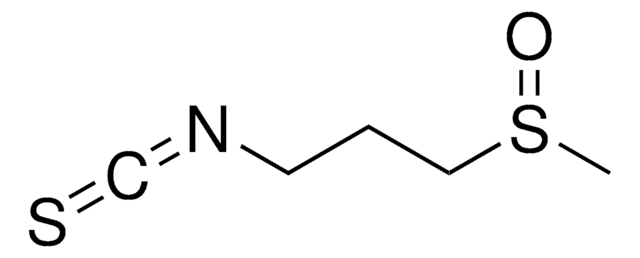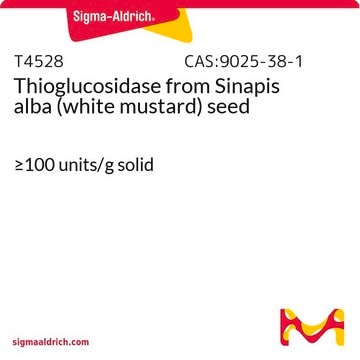S6317
L-Sulforaphane
≥95% (HPLC), oil
Sinonimo/i:
(R)-1-Isothiocyanato-4-(methylsulfinyl)butane, 4-Methylsulfinylbutyl isothiocyanate
About This Item
Prodotti consigliati
Saggio
≥95% (HPLC)
Forma fisica
oil
Attività ottica
[α]/D -70 to -90°, c = 1.0 in chloroform-d
Colore
light yellow
Solubilità
DMSO: >5 mg/mL
Temperatura di conservazione
−20°C
Stringa SMILE
CS(=O)CCCCN=C=S
InChI
1S/C6H11NOS2/c1-10(8)5-3-2-4-7-6-9/h2-5H2,1H3/t10-/m1/s1
SUVMJBTUFCVSAD-SNVBAGLBSA-N
Cerchi prodotti simili? Visita Guida al confronto tra prodotti
Applicazioni
Azioni biochim/fisiol
Codice della classe di stoccaggio
11 - Combustible Solids
Classe di pericolosità dell'acqua (WGK)
WGK 3
Punto d’infiammabilità (°F)
Not applicable
Punto d’infiammabilità (°C)
Not applicable
Dispositivi di protezione individuale
Eyeshields, Gloves
Certificati d'analisi (COA)
Cerca il Certificati d'analisi (COA) digitando il numero di lotto/batch corrispondente. I numeri di lotto o di batch sono stampati sull'etichetta dei prodotti dopo la parola ‘Lotto’ o ‘Batch’.
Possiedi già questo prodotto?
I documenti relativi ai prodotti acquistati recentemente sono disponibili nell’Archivio dei documenti.
I clienti hanno visto anche
Articoli
DISCOVER Bioactive Small Molecules for Nitric Oxide & Cell Stress Research
Il team dei nostri ricercatori vanta grande esperienza in tutte le aree della ricerca quali Life Science, scienza dei materiali, sintesi chimica, cromatografia, discipline analitiche, ecc..
Contatta l'Assistenza Tecnica.














